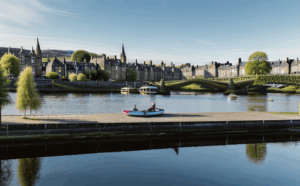Concerns are mounting in Perth regarding the safety of jet-ski users on the River Tay. A recent near-miss incident has prompted renewed calls for stricter regulations, particularly focusing on areas near Perth Harbour and the city’s iconic North Inch.
A prominent local figure, formerly associated with the Perth Harbour Board, is advocating for a bylaw to manage jet-ski activity. He argues that the current informal code of conduct, while well-intentioned, lacks the legal weight to effectively prevent reckless behaviour and ensure the safety of other river users and wildlife. This individual points to a recent near-collision as a stark illustration of the risks involved. Existing Guidelines and Their Limitations
The current guidelines for jet-skiers on the Tay, established by regular users, encompass a designated area, operational hours, speed restrictions, and noise limits. Speed limits are particularly strict around the harbour mouth, reducing to 5 mph, and increase to 10 mph beyond the Friarton Yacht Club. The designated zone extends from the northern edge of the North Inch eastward to just past the Friarton Bridge, but enforcing these voluntary limitations presents significant challenges.
The council’s approach focuses on encouraging responsible behaviour through the voluntary code of conduct. This relies heavily on the self-regulation of jet-skiers. However, the recent near-miss underscores the shortcomings of this approach and highlights the need for more robust enforcement. The Argument for a Bylaw
Proponents of a bylaw contend that a legally binding framework is essential for several reasons. Firstly, a bylaw would provide a clearer definition of acceptable jet-ski use, eliminating any ambiguity in the current guidelines. Secondly, it would allow for more effective enforcement mechanisms, addressing instances of unsafe behaviour and violations of agreed-upon parameters. Thirdly, a bylaw would better protect both the natural environment and the wider community of boaters and recreational users of the River Tay. The council’s position, while emphasising its commitment to public safety, does not currently include plans to implement any changes in this regard. The Harbour Board’s Role and Dissolution
The issue of jet-ski regulation has gained prominence following the council’s decision to disband the Perth Harbour Board, a move that has caused considerable controversy in the city. The Harbour Board had been reviewing the existing regulatory framework prior to its dissolution, and its removal has left a regulatory gap which some argue further exacerbates the safety issues on the river.
The council’s decision to disband the Harbour Board was made in an effort to resolve a protracted disagreement with Transport Scotland regarding the harbour’s financial viability. For over a year, the debate over the harbour’s future has resulted in substantial losses for the council in terms of both operational costs and lost revenues. Despite its dissolution, the council will retain its statutory harbour authority, though with reduced oversight of the larger commercial vessels on the river. Community Concerns and Future Prospects
The debate surrounding jet-ski regulations has sparked passionate discussions within the Perth and Kinross community. Many residents, particularly those living near the River Tay, feel the existing code of conduct is insufficient. They highlight increased jet-ski activity as a source of potential danger and environmental disruption. The former chair of the Harbour Board’s suggestion of bylaws is seen by many as a timely and crucial step towards safeguarding public safety and preserving the beauty of the River Tay.
The council remains committed to promoting the safe use of the River Tay but isn’t considering the implementation of a bylaw at this time. However, the recent near-miss and community concerns underline the potential need for more stringent regulations in the future, and the possibility of revisiting the issue should additional incidents occur or if significant public pressure mounts for changes. This ongoing discussion highlights the ongoing dialogue between the council, residents and recreational users on the responsible use of Perth’s beloved river.
The recent events bring to the forefront the importance of finding a balance between recreational activities and public safety, environmental protection, and the overall well-being of the Perth and Kinross community. Further engagement with stakeholders will likely be essential in charting a path forward that addresses all concerns effectively.
A prominent local figure, formerly associated with the Perth Harbour Board, is advocating for a bylaw to manage jet-ski activity. He argues that the current informal code of conduct, while well-intentioned, lacks the legal weight to effectively prevent reckless behaviour and ensure the safety of other river users and wildlife. This individual points to a recent near-collision as a stark illustration of the risks involved. Existing Guidelines and Their Limitations
The current guidelines for jet-skiers on the Tay, established by regular users, encompass a designated area, operational hours, speed restrictions, and noise limits. Speed limits are particularly strict around the harbour mouth, reducing to 5 mph, and increase to 10 mph beyond the Friarton Yacht Club. The designated zone extends from the northern edge of the North Inch eastward to just past the Friarton Bridge, but enforcing these voluntary limitations presents significant challenges.
The council’s approach focuses on encouraging responsible behaviour through the voluntary code of conduct. This relies heavily on the self-regulation of jet-skiers. However, the recent near-miss underscores the shortcomings of this approach and highlights the need for more robust enforcement. The Argument for a Bylaw
Proponents of a bylaw contend that a legally binding framework is essential for several reasons. Firstly, a bylaw would provide a clearer definition of acceptable jet-ski use, eliminating any ambiguity in the current guidelines. Secondly, it would allow for more effective enforcement mechanisms, addressing instances of unsafe behaviour and violations of agreed-upon parameters. Thirdly, a bylaw would better protect both the natural environment and the wider community of boaters and recreational users of the River Tay. The council’s position, while emphasising its commitment to public safety, does not currently include plans to implement any changes in this regard. The Harbour Board’s Role and Dissolution
The issue of jet-ski regulation has gained prominence following the council’s decision to disband the Perth Harbour Board, a move that has caused considerable controversy in the city. The Harbour Board had been reviewing the existing regulatory framework prior to its dissolution, and its removal has left a regulatory gap which some argue further exacerbates the safety issues on the river.
The council’s decision to disband the Harbour Board was made in an effort to resolve a protracted disagreement with Transport Scotland regarding the harbour’s financial viability. For over a year, the debate over the harbour’s future has resulted in substantial losses for the council in terms of both operational costs and lost revenues. Despite its dissolution, the council will retain its statutory harbour authority, though with reduced oversight of the larger commercial vessels on the river. Community Concerns and Future Prospects
The debate surrounding jet-ski regulations has sparked passionate discussions within the Perth and Kinross community. Many residents, particularly those living near the River Tay, feel the existing code of conduct is insufficient. They highlight increased jet-ski activity as a source of potential danger and environmental disruption. The former chair of the Harbour Board’s suggestion of bylaws is seen by many as a timely and crucial step towards safeguarding public safety and preserving the beauty of the River Tay.
The council remains committed to promoting the safe use of the River Tay but isn’t considering the implementation of a bylaw at this time. However, the recent near-miss and community concerns underline the potential need for more stringent regulations in the future, and the possibility of revisiting the issue should additional incidents occur or if significant public pressure mounts for changes. This ongoing discussion highlights the ongoing dialogue between the council, residents and recreational users on the responsible use of Perth’s beloved river.
The recent events bring to the forefront the importance of finding a balance between recreational activities and public safety, environmental protection, and the overall well-being of the Perth and Kinross community. Further engagement with stakeholders will likely be essential in charting a path forward that addresses all concerns effectively.


